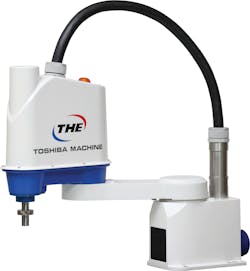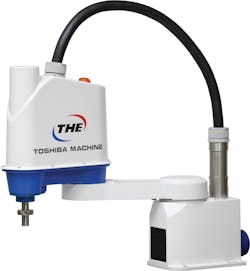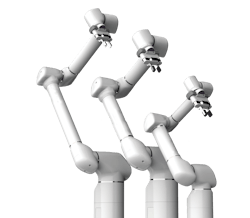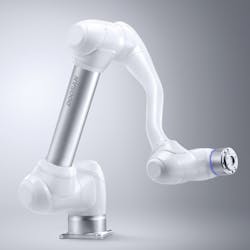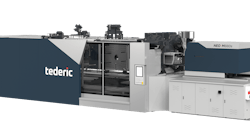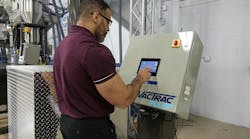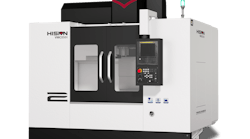TM Robotics, Productive Robotics and Ready Robotics also showed control and vision packages that make controlling and using robots easier.
There are also new nameplates jumping into the strong North American market. South Korea’s Doosan Robotics, a major robot builder in Asia, entered the European market last year and had one of the biggest booths at Automate 2019 for its North American debut.
TM ROBOTICS
TM Robotics launched its THE600 SCARA robot specifically for applications that require high speed and heavy payload capacity, frequent requirements in the automotive, pharmaceutical packaging and electronic assembly industries.
Those industries are looking for a very rigid robot that offers quality performance, longevity and low cost, a TM Robotics spokesman said. THE600 was designed to fill these needs.
THE600 joins the smaller THE400 in the series, which debuted last year.
THE600 has a 23.6-inch reach, maximum payload of 26.4 pounds and standard cycle time of 0.34 second.
TM Robotics President Nigel Smith said THE600 is twice as fast and has a 60 percent bigger payload capacity than similar models in the same price range from other manufacturers.
“Manufacturers are looking for machines to deliver improved precision and enhanced performance without breaking the bank, particularly in parts assembly, testing and transfer processes,” Smith said.
The robot has a built-in PLC, and the company said it is easy to program.
TM Robotics also showed its new programming assistance tool called TSAssist for the first time. The new software is compatible with all of Toshiba’s SCARA, Cartesian and six-axis robots. It features 3-D simulation, a program editor and an easy-to- understand, intuitive design.
The 3-D simulation function includes an accurate interference check, locus display, cycle time measurement and multiple-angle views. 3-D CAD files can be uploaded and 3-D simulations can be saved to a video file.
The locus display function is the ability to track the center point of the robot’s tool as the robot moves through the work cell. Tracking the robot through the duration of the cycle is useful for the plastics industry. For example, when using a Toshiba take-out robot, the locus display in the simulation function lets the user ensure timing has been optimized so the mold can close and begin the next cycle as soon as the tool center point is clear of the mold.
TM Robotics also unveiled its TS5000 controller and the TP5000 teach pendant. The features are standard with its THE600, and will be available with subsequent new models.
The controller is designed for Industry 4.0 and needs 33 percent less space than the current controller. It has dedicated ports for status feedback and control, freeing up other ports for priority communications such as vision interfacing and system control.
The new teach pendant has a 7-inch screen, is lightweight and durable, and supports multiple languages.
PRODUCTIVE ROBOTICS
The OB7-Max 12 has a 26-pound payload capacity, 51.2-inch reach and weighs 127 pounds; the OB7-Max 8 can lift 17 pounds, has a 66.9-inch reach and weighs 128 pounds. The OB7 has an 11-pound payload capacity and 39.4-inch reach.
All three of the cobots have a repeatability accuracy to within 0.1mm.
They require no programming. All learn tasks by demonstration.
A Productive Robotics spokesman said the new models are especially suited for machine tending, gluing, welding, polishing, grinding and quality-control tasks. He said they are a good starting point for a company new to robotics.
Productive Robotics also debuted OB Vision, which it describes as a commonsense and automatic approach to robot vision.
Like the OB7 series of cobots, the vision package does not require programming to use. An operator just shows the OB7 what needs to be picked up, pushes a button and OB Vision learns to recognize the object and direct the cobot to pick it up.
It has a working area of 12 inches to 18 inches and can recognize objects as small as 1 inch and as large as 8 inches within about 1 second. It has integrated lighting.
OB Vision is integrated in the OB7 learning system and available for all three cobots as an option.
The Productive Robotics units are designed and manufactured in the U.S.
DOOSAN ROBOTICS
The four Doosan cobots have a working radius of 35.4 inches to 66.9 inches and a load capacity from 13.2 pounds to 33.1 pounds. The company uses a proprietary torque sensor on all six joints.
The company said its teach pendant is intuitive and easy to operate. Complicated scripts are not required.
Doosan says it has the largest market share for cobots in Korea.
“We are in the middle of the fourth Industrial Revolution, where collaborative robots play a key role,” said Byungseo Lee, CEO of Doosan Robotics. “Humans will be increasingly empowered to achieve higher levels of efficiency and immediate productivity gains through harnessing technology.”
The M0609, with 13.2-pound capacity and 35.4-inch working radius, is optimized to perform repetitive tasks at high speeds in a limited space.
The M1509, with 33.1-pound capacity and 35.4-inch working radius, is designed to handle heavier objects.
The M1013, with a 28.7-pound capacity and 51.2-inch working radius, is the standard model.
The M0617, with a 13.2-pound load and 66.9-inch working radius, is for applications requiring multiple tasks or tasks that require a long reach.
Doosan Robotics is based in Suwon, near Seoul. The company is building a U.S. sales network.
READY ROBOTICS
Controlling multiple robots operating at the same time can be difficult and time-consuming unless there is a control system such as Ready Robotics’ new plug-and-play Forge/Ctrl system.
Forge/Ctrl consists of a hardware controller running software called Forge/OS. The Forge/Ctrl system uses a touch-screen interface.
Any industrial or collaborative robot can be plugged into the system, as well as pneumatic peripherals, sensors and grippers through standardized interfaces. The system will connect to older machine tools. It also can be connected to injection molding machines through a PLC interface.
No previous programming experience is needed, according to Ben Gibbs, CEO and one of the founders of Ready Robotics. “No robotics training is needed,” Gibbs said. “It lowers the barrier to robotics usage.” Programming steps follow a flow-chart-style progression.
He said reducing downtime by making programming easier is a significant benefit of the system.
Examples of how Forge/Ctrl can save time include setting up a pick-and-place task, an assembly task or a palletizing function with different robots.
Forge/Ctrl also works with industrial robotic arms. Typical functions are sorting and inspection.
Pneumatic and 24-volt digital I/O are included. The unit requires an air supply with 90 psi to 100 psi and 120-volt current.
Ron Shinn, editor
Contact:
Doosan Robotics Inc.,
Suwon, South Korea, 82-31-8014-5500, www.doosanrobotics.com/en
Productive Robotics Inc.,
Carpinteria, Calif., 805-244-9300, www.productiverobotics.com
Ready Robotics,
Columbus, Ohio, 833-732-3967, www.ready-robotics.com
TM Robotics Inc.,
Elk Grove Village, Ill., 847-709-7308, www.tmrobotics.com
